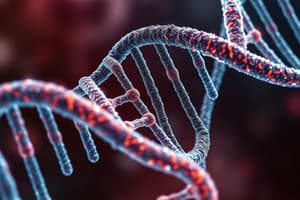Podcast
Questions and Answers
What are the three parts of a nucleotide?
What are the three parts of a nucleotide?
Phosphate, sugar, nitrogen base
What is a nucleotide?
What is a nucleotide?
Basic unit
What is surgery in DNA?
What is surgery in DNA?
Deoxyribonucleic
What do hydrogen bonds do?
What do hydrogen bonds do?
What is a covalent bond?
What is a covalent bond?
What is ionic bonding?
What is ionic bonding?
What are the 4 nitrogen bases?
What are the 4 nitrogen bases?
What is DNA?
What is DNA?
A polymer is a ______________ that is made of ______________.
A polymer is a ______________ that is made of ______________.
Purines are ___________ and have ______________.
Purines are ___________ and have ______________.
How many rings does G have?
How many rings does G have?
How many rings does C have?
How many rings does C have?
G and A are what type of bases?
G and A are what type of bases?
What are pyrimidines?
What are pyrimidines?
Total pairs of chromosomes are ___________ and ___________.
Total pairs of chromosomes are ___________ and ___________.
What type of extraction is different?
What type of extraction is different?
Short segments of DNA code for a _______.
Short segments of DNA code for a _______.
What is a cytocentrifuge?
What is a cytocentrifuge?
What is PCR?
What is PCR?
Study Notes
Nucleotide Structure
- Composed of three main components: phosphate group, sugar, and nitrogen base.
- Nitrogen bases include four types: cytosine (C), thymine (T), adenine (A), and guanine (G).
DNA Characteristics
- DNA, short for deoxyribonucleic acid, acts as a polymer, made up of repeating units called monomers.
- The structure of DNA is maintained by hydrogen bonds that link complementary nitrogen bases.
Types of Bonds
- Covalent bonds involve the sharing of electrons between atoms.
- Ionic bonds are formed through the attraction between two ions.
Nitrogen Base Classification
- Purines (adenine and guanine) consist of two rings in their structure.
- Pyrimidines (cytosine and thymine) have a single ring.
Genetic Structure and Function
- A gene is a short segment of DNA that encodes for a specific protein or trait.
- Human cells typically contain 46 total chromosomes, organized into 23 pairs.
DNA Extraction and Profiling
- DNA extraction techniques vary, particularly between plant and animal samples.
- DNA profiling involves several steps: collect, extract, amplify (using PCR - polymerase chain reaction), and analyze the genetic material.
Laboratory Equipment
- A cytocentrifuge is a tool used for spinning and concentrating biological samples.
Studying That Suits You
Use AI to generate personalized quizzes and flashcards to suit your learning preferences.
Description
Explore the fundamental components of nucleotides and DNA in this quiz. Dive into the characteristics of DNA, types of bonds, and the classification of nitrogen bases. Understand the genetic structure and functions, including DNA extraction techniques.




